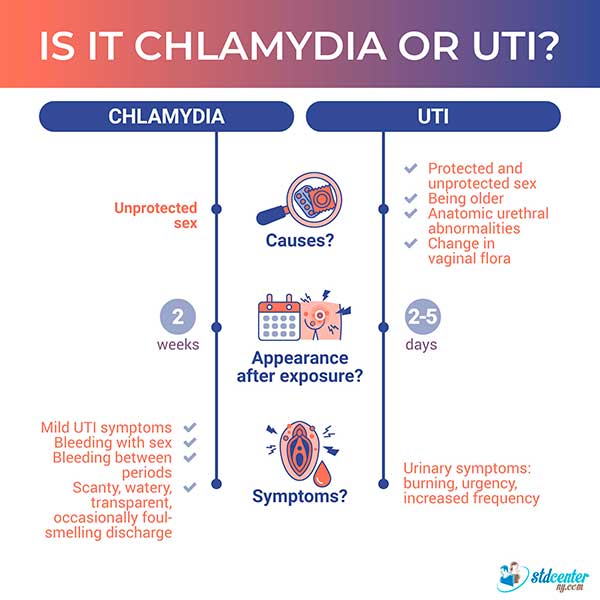X
How to tell the difference between Chlamydia and UTI.
In this article we will compare chlamydia to UTI (bladder infection). The most significant differentiating sign and symptoms will be noted.
The comparison will be in two parts:
1. History of symptoms
- What caused the symptoms?
- How soon did they appear after exposure (that is, how long was the incubation period)?
- How are the symptoms changing over time?
2. Visual exam
- Discharge and its characteristics (color, amount, and consistency)
- Genital area
Disclaimer: Although the information in this article may help differentiate chlamydia from similar conditions, the definitive diagnosis can be established only after proper testing (a swab or urine test).
By Slava Fuzayloff | Published on November 17, 2023
Chlamydia or UTI - learn how to tell the difference. Expert STD doctor explains.
Bladder infection, or UTI, [5] Urinary tract infection (UTI) https://www.mayoclinic.org/diseases-conditions/urinary-tract-infection/symptoms-causes/syc-20353447 is a common medical condition affecting mostly females. It is caused from an infection being pushed into the bladder through the urethral opening. Males rarely get UTI because they have a longer urethra.
History of symptoms
What preceded the appearance of symptoms?
Unlike chlamydia, [1] Chlamydia – CDC Basic Fact Sheet https://www.cdc.gov/std/chlamydia/stdfact-chlamydia.htm which is transmitted only via unprotected sex, UTI can be caused by sex (both protected and unprotected) and other things:
✓ A structural (anatomic) problem that make someone predisposed to it.
✓ A change in vaginal flora
✓ Being older
✓ Poor hygiene
How soon did symptoms appear?
Unlike chlamydia, [2] Chlamydia Symptoms https://www.nhs.uk/conditions/chlamydia/symptoms/ which has an average incubation period of two weeks, UTI symptoms [4] Urinary tract infection (UTI) https://www.nhsinform.scot/illnesses-and-conditions/kidneys-bladder-and-prostate/urinary-tract-infection-uti/ can appear as early as the day after exposure. Some UTIs, however, can take 3–8 days to become apparent.
How are symptoms changing over time?
Both conditions can start as burning, urgency, and increased frequency of urination. However, there are differences:
✓ UTI symptoms (especially burning in the urethra with urination) are usually more significant and progress quickly (in 2–5 days) to lower abdominal pain. Bloody urine is not uncommon. Untreated UTI can progress to kidney infection that causes mid-back pain, fever, and chills.
✓ Chlamydia’s urinary symptoms are usually milder, and the disease takes time to progress.
✓ In addition to urinary symptoms, chlamydia can cause vaginal discharge. It takes time to appear (2 weeks on average).
✓ Untreated chlamydia can cause spotting between periods, bleeding with sexual activity, and lower abdominal pain, and it can progress to pelvic inflammatory disease (PID) or, in males, epididymitis (infection of the tube at the back of the testicles) in males. It usually takes a few weeks for complications to occur.
What can be seen during a visual exam?
Urine
Unlike chlamydia, UTI can cause cloudy, strong-smelling, and bloody urine.
Vaginal discharge
Unlike UTI (which does not cause an unusual discharge), chlamydia [3] Chlamydia https://my.clevelandclinic.org/health/diseases/4023-chlamydia can cause an abnormal vaginal or urethral discharge that is scanty, watery, and transparent.
Genital area
Chlamydia can cause minimal swelling and redness of the vaginal and urethral openings, unlike UTI.

Source
- Chlamydia – CDC Basic Fact Sheet
https://www.cdc.gov/std/chlamydia/stdfact-chlamydia.htm - Chlamydia Symptoms
https://www.nhs.uk/conditions/chlamydia/symptoms/ - Chlamydia
https://my.clevelandclinic.org/health/diseases/4023-chlamydia - Urinary tract infection (UTI)
https://www.nhsinform.scot/illnesses-and-conditions/kidneys-bladder-and-prostate/urinary-tract-infection-uti/ - Urinary tract infection (UTI)
https://www.mayoclinic.org/diseases-conditions/urinary-tract-infection/symptoms-causes/syc-20353447

By Slava Fuzayloff. D.O
Dr. Slava Fuzayloff is practicing STD physician with 20 years of experience and expert writer in the field of the sexually transmitted diseases.